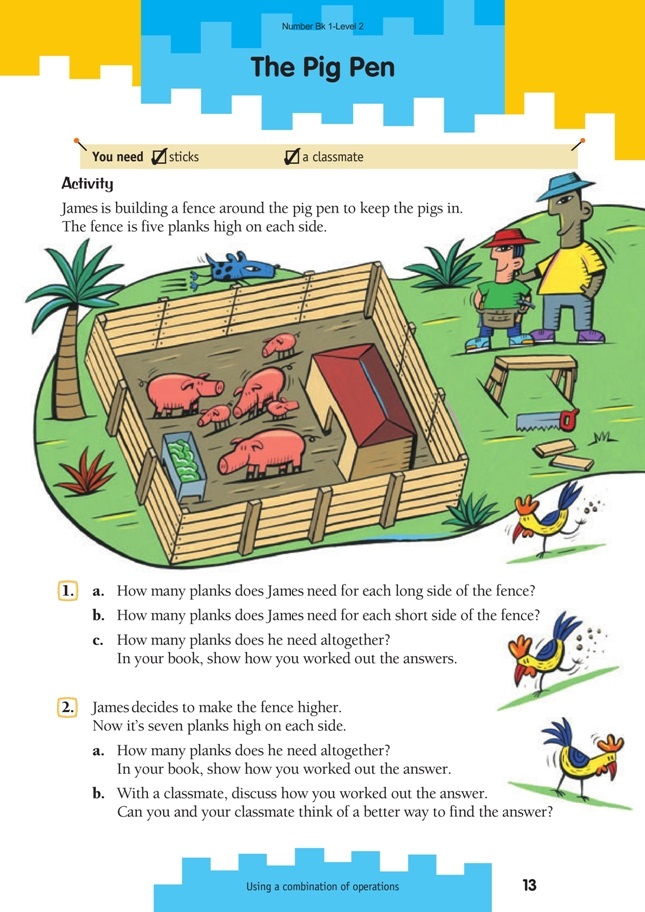This is a level 2 number activity from the Figure It Out series. It relates to Stage 5 of the Number Framework.
A PDF of the student activity is included.
Click on the image to enlarge it. Click again to close. Download PDF (293 KB)
solve story problems using simple additive strategies
FIO, Level 2, Number, Book 1, The Pig Pen, page 13
sticks
classmate
These problems involve combining equal groups to find a total. There is a variety of strategies that the students can use to solve the problems.
For question 1, the students’ strategies for finding the planks for the long side might include:
• using repeated addition: 5 + 5 + 5 + 5 = 20
• skip-counting in fives: 5, 10, 15, 20
• using doubles: double 5 is 10, and double 10 is 20
• recalling known facts: 4 times 5 is 20
The students can use similar strategies to calculate the planks for the short sides of the fence in question 1b.
There is also an opportunity here to reinforce what the students already know about rectangles: both the long sides are the same length, and both the short sides are the same length. So when the students have worked out that 20 planks are needed for one long side, they do not need to work out the answer for the other long side.
For question 1c, the students could use any of these strategies:
• 20 and 20 is 40, and 15 more is 55, and 15 more makes 70 planks altogether.
• Double 20 and double 15 is the same as 40 and 30, which is 70 planks.
• 20 plus 15 is 35. That’s for half the fence, so I double it to get 70 planks for the whole fence.
In question 1, the students have worked out how many planks Jamal will need when each section of the fence is five planks high. The illustration supports this. So when the students are asked to calculate the total number of planks if the fence is seven planks high in question 2, the visual information encourages them to use a strategy of adding two planks all the way around.
The many strategies that the students could use to find out how many planks Jamal needs for the higher fence include:
• using the answers for question 1: there are four sections in each long side and two more planks in each section, so that’s eight more planks on each long side. There are three sections in each short side, so that’s 3 x 2 = 6 more planks on each short side. Altogether, that’s 8 + 8 + 6 + 6 = 28 more planks to add to 70.
• using five-based strategies: there are 14 sections in the fence: 14 fives are 70. There are 14 more twos … that’s 28. 70 and 28 is 98.
• working with multiples of 10: 10 sections would take 10 x 7 = 70 planks. Four more sections would be 4 x 7 = 28. 70 + 28 = 98.
After the students have finished question 2 and discussed how they worked out the answer, you could have a class discussion about the most efficient strategies for these problems and what makes one strategy more efficient than another.
Answers to Activity
1. a. 20 planks
b. 15 planks
c. 70 planks (20 x 2 = 40 and 15 x 2 = 30. 40 + 30 = 70)
2. a. 98 planks. Two ways of working this out are:
• each long side: 4 x 7 = 28
each short side: 3 x 7 = 21
total planks needed: 28 + 28 + 21 + 21 = 98
• A five-plank-high fence needs 70 planks.
Extra planks needed for each long side: 4 x 2 = 8
extra planks needed for each short side: 3 x 2 = 6
total planks needed: 70 + 8 + 8 + 6 + 6 = 98
b. Answers will vary.
